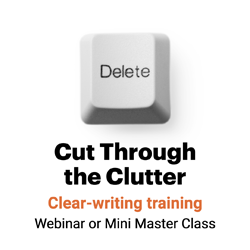4 steps to Cutting Through the Clutter
You’ve prewritten and freewritten your message. Now it’s time to rewrite it.

Here’s where you’ll edit, hit readability targets, and nail spelling, grammar and punctuation. This is what we used to call writing!
Here’s a checklist for getting the job done.
1. Check your point.
Is your topic sentence — aka nut graph — doing its job? Will readers need to hold study sessions to figure out what you’re trying to say? This isn’t a test-your-knowledge project: Your most important point should be clear and easy to understand.
2. Check your structure.
Whether you use mind maps, a Roman-numeral outline or — our favorite! — the three-boxes structure — make sure your organizational plan is holding up. An important part of your revision timetable is making sure your message makes sense and flows.
3. Check for clutter.
A big part of your revision time will focus on readability. So start revising your:
- Piece as a whole. Readers spend only a minute or two on the average brand message. If yours is much longer than that, you’ll lose control of the message. Remember, this isn’t a 10-page, essay-based assignment! Chances are your message would be twice as good if it were half as long.
- Paragraphs. Readers skip long paragraphs, so count the sentences of each paragraph to make sure yours is not too long.
- Sentences. Readers struggle to understand long sentences, so if yours are too long, you may not get the comprehension you need.
- Words. Word choice is the No. 1 predictor of readability. Reduce your average word length in characters. Replace adjectives and adverbs with stronger nouns and verbs. Translate jargon from the language of the organization into the language of the reader.
- Passive voice. One of the easiest revision techniques is to activate the passive voice: Write Subject, Verb, Object — not Object, Verb, Subject.
- Statistics. Writing with statistics? Take the numb out of numbers: Avoid statistics soup and other data dumps.
- Readability. All of these approaches will help you boost your Flesch Reading Ease, a scale of zero to 100 that measures quantifiably how easy your message is to read. The higher your number, the better your user experience.
4. Check your tone.
Make sure your message sounds the way you speak. Read your copy aloud. If it sounds delightful and conversational, like you, it’s good to go. If it sounds stiff and formal, soften the language.
Every day is Bring Your Personality to Work day when you’re a professional communicator. Choose a business casual writing style.

Leave a Reply